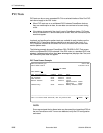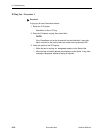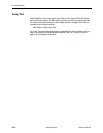
8. Troubleshooting
8-26 December 2002 9700-A2-GB20-20
Encapsulation
Available Settings: Routed
Default Setting: Routed
Specifies the IP encapsulation used by the data stream. This read-only field specifies that
the IP encapsulation used is RFC 1490/RFC 2427 routed Network Level Protocol
IDentifier (NLPID) encapsulation, and not SubNetwork Access Protocol (SNAP)
encapsulation.
Display Conditions
– This setting does not appear when Destination Interface is set to
Use_Internal_Route.
Routed – The encapsulation is routed NLPID.
TOS Byte
Available Settings: A predefined COS ID, or a user-defined binary value 0000–1111
Default Setting: User Defined – 000000
(Release 2.1.) Specifies the TOS (Terms Of Service) byte to be used with the ping packet.
Select from COS (Class Of Service) definitions, if any exist, or specify a binary value.
When a COS definition is selected, the TOS byte value is read-only. If you select a COS
definition that has multiple COS IDs, the lowest value is used as the TOS byte. See
Configuring Class of Service Definitions
in Chapter 4,
Configuration Options
.
0000–1111 – The value of the TOS byte.
Packet Size
Available Settings: 36–4096
Default Setting: 100
Specifies the size of the ping packet including the IP header (20 bytes) and the ICMP
header (8 bytes).
1–4096 – Packet size.
Iteration Count
Available Settings: 1–999999
Default Setting: 5
Specifies the number of pings to send.
1–999999 – Number of pings.
Inter-Ping Delay
Available Settings: 1–900
Default Setting: 1
Specifies, in seconds, the amount of time to wait between pings.
1–900 – The ping wait time.
Response Timeout
Available Settings: 1–60
Default Setting: 2
Specifies the amount of time, in seconds, to wait before a host that has not responded to a
ping is declared unreachable.
1–60 – The response timeout period.
Table 8-5. Ping Options (2 of 2)


















